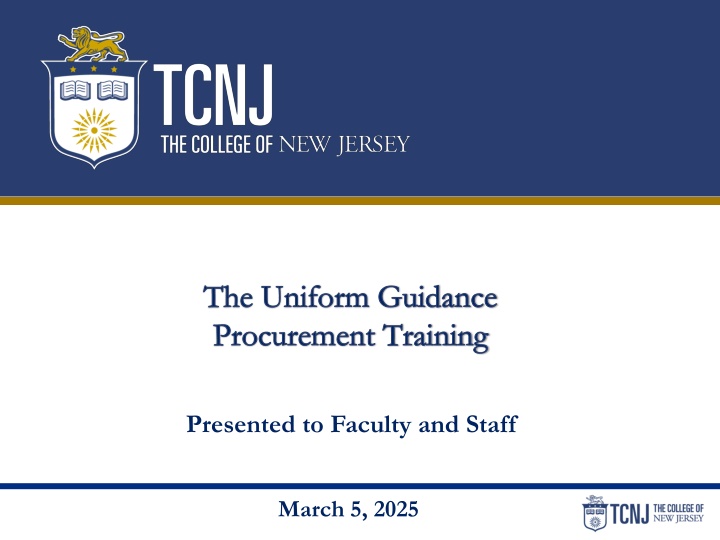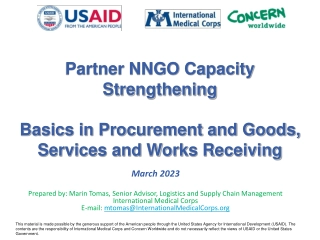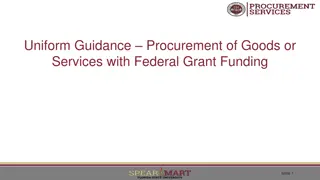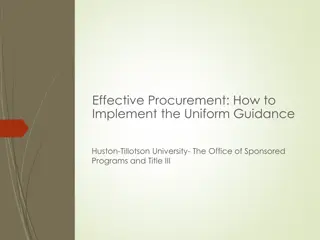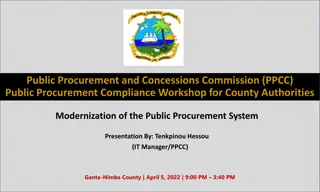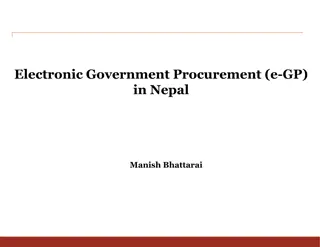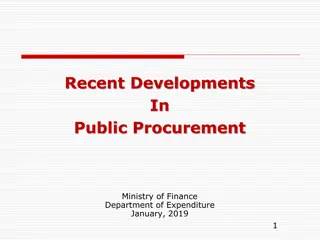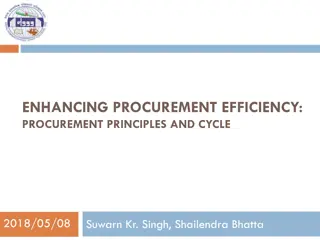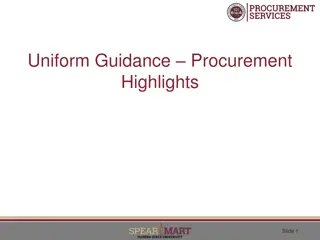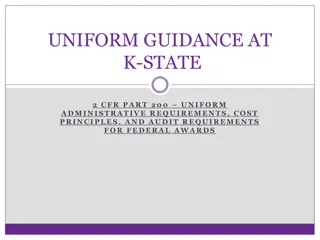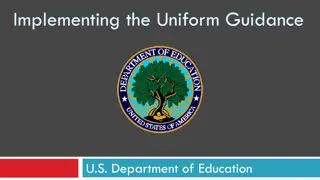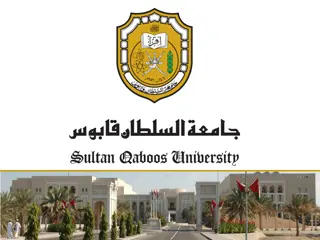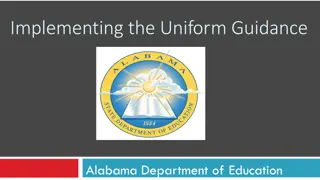The Uniform Guidance Procurement Training
Uniform Guidance Procurement training provided insights on key changes, roles, and responsibilities. The training emphasized understanding the Uniform Guidance regulations for procurement, ensuring clarity on responsibilities, and providing resources for further guidance. The session covered background information, overview of changes, effective dates for existing awards, and institutional impacts of the Uniform Guidance. Key takeaways included a comprehensive understanding of the regulations and the importance of compliance with procurement standards in institutions. The final guidance highlighted the need for adherence to procurement method requirements outlined by the OMB Uniform Guidance.
Download Presentation

Please find below an Image/Link to download the presentation.
The content on the website is provided AS IS for your information and personal use only. It may not be sold, licensed, or shared on other websites without obtaining consent from the author.If you encounter any issues during the download, it is possible that the publisher has removed the file from their server.
You are allowed to download the files provided on this website for personal or commercial use, subject to the condition that they are used lawfully. All files are the property of their respective owners.
The content on the website is provided AS IS for your information and personal use only. It may not be sold, licensed, or shared on other websites without obtaining consent from the author.
E N D
Presentation Transcript
The Uniform Guidance Procurement Training Presented to Faculty and Staff March 5, 2025 0
Agenda and Outcomes Agenda Introductions Background on the Uniform Guidance The Basic Idea Procurement Roles and Responsibilities Processes Key Takeaways Resources Outcome: After this training we expect that you should have an understanding of the Uniform Guidance and the changes to the regulations for procurement. You should know your responsibilities, and know where to find answers to any questions that may arise. 1
1. Background on The Uniform Guidance 2
Background on Uniform Guidance OVERVIEW OF CHANGES The Uniform Guidance includes a combination of: Current Language from Existing Circulars Revised Language of Existing Circulars New Language The final guidance which went into effect December 26, 2014 superseded requirements from: OMB Circulars A-21, A-87, A-110, and A-122 (which have been placed in 2 C.F.R. Parts 220, 225, 215, and 230), Circulars A-89, A-102, and A-133 The guidance in Circular A-50 on Single Audit Act follow-up What Changed? What Remained the Same? Combined 8 Circulars into 1 Adjusted and revised the language and added new language Granted greater flexibility to the recipient Placed greater emphasis on institutional policies and internal controls In many respects the guidance remains unchanged However, just the change itself will result in increased scrutiny because of the renewed awareness and focus 3
Overview of Uniform Guidance & Institutional Impact EFFECTIVE DATES EXISTING AWARDS & GUIDANCE Existing Awards Pre-Existing Guidance Once the Uniform Guidance goes into effect for non-Federal entities, it will apply to Federal awards or funding increments after that date. It will not retroactively change the terms and conditions. Entities will likely make changes to their own policies and procedures that will impact their existing/older awards. Non-Federal entities wishing to implement entity-wide system changes to comply with the Uniform Guidance after the effective date of December 26, 2014 will not be penalized for doing so. TCNJ has adopted policies and procedures that impact existing awards. The terms and conditions for Federal awards (i.e. 2 CFR 220, 225, and 230) always govern. The Uniform Guidance is now in effect, Federal agencies need to ensure the continued availability of access to the terms and conditions of Federal awards made prior to the Uniform Guidance becoming effective. 4
Overview of Uniform Guidance & Institutional Impact COST PRINCIPLES - PROCUREMENT Institutions will have additional procurement standards such as required competition and equipment screening requirements. FINAL OMB UNIFORM GUIDANCE Procurement method requirements are outlined. INSTITUTIONAL IMPACTAND IMPLICATIONS The cost or price analysis threshold, set in accordance with the simplified acquisition threshold, will streamline institutional procurement processes. The threshold for small purchase procedures is raised to $150,000 to be consistent with the simplified acquisition threshold in the Federal Acquisition Regulation (FAR). However, other actions will require additional administration in procurement areas, such as inter-entity agreements for shared services. Non-Federal entities are required to avoid duplicative purchases and encouraged to enter into agreements for shared goods and services. Institutional P-Card policies, especially for purchases over $3,000 may be in conflict with Federal requirements. All A-110 language on procurement is replaced by A-102 section .36. TCNJ will continue to follow its existing procurement policies which comply with the new Federal requirements. Minor clarification to language requires non- Federal entities to maintain oversight rather than a system that ensures contractor performance. 5
2. Procurement 6
Administrative Requirements PROCUREMENT - INTRODUCTION The procurement standards (in sections 200.317 through 200.326) are generally based on the requirements in A-102 for states, local governments and Indian tribes - with modifications States use their own policies and procedures as a state entity, TCNJ follows the State of NJ procurement rules All other non-Federal entities, including subrecipients of a state, must have and follow written procurement procedures that reflect the procurement standards General Procurement Requirements: The non-Federal entity must maintain oversight to ensure that contractors perform in accordance with the terms, conditions, and specifications of the contract or purchase order The non-Federal entity is not required to maintain a contract administration system How the non-Federal entity maintains oversight is a matter of judgment for the non-Federal entity 7
Administrative Requirements PROCUREMENT STANDARDS OF CONDUCT Procurement Standards of Conduct: Regulation Description 200.318(c)(1) The non-Federal entity must maintain written standards of conduct covering conflicts of interest and governing the performance of its employees engaged in the selection, award, and administration of contracts 200.318(c)(2) New provision that covers organizational conflict of interest If the non-Federal entity has a parent, affiliate, or subsidiary organization (that is not a state, local government, or Indian tribe), the non-Federal entity must also maintain written standards of conduct covering organizational conflicts of interest 200.318(d) The non-Federal entity s procedures must avoid acquisition of unnecessary or duplicative items 200.318(e) To foster greater economy and efficiency and to promote cost-effective use of shared services, the non-Federal entity is encouraged to enter into state and local intergovernmental agreements or inter-entity agreements where appropriate for procurement or use of common or shared goods and services 200.318(f) The non-Federal entity is encouraged to use Federal excess and surplus property in lieu of purchasing new equipment and property when this is feasible and reduces project costs 8
Administrative Requirements PROCUREMENT METHODS OF PROCUREMENT TCNJ requires 5 distinct methods for procurement of goods and services check the Purchasing webpage at http://finance.tcnj.edu/purchasing/purchasing-guidelines/ as the thresholds are subject to change 1. Micro-Purchases Up to $2,500 Price competition is recommended but not required departments responsible for getting the best value The Principal Investigator is responsible for authorizing these purchases 2. Small Purchase Procedures Greater than $2,500, Less than $6,600 Price competition must be obtained for all purchases or purchases of goods (minimum of 3 quotes) Department Chair/Director is responsible for authorizing these purchases and all purchases are subject to audit Prior to making purchases that exceed $4,950, departments must obtain a New Jersey Business Registration Certificate from the vendor 3. Informal Bids Greater than $6,600 but less than $33,000 Price competition is required for purchases of goods or services The department requesting the purchase will coordinate the awarding of the contract with the Purchasing Department, where a purchase order will be issued. 9
Administrative Requirements PROCUREMENT METHODS OF PROCUREMENT TCNJ requires 5 distinct methods for procurement of goods and services (continued) 4. Advertised Bids Greater than $33,000 Price competition is required for purchases of goods or services Departments requiring the goods or services must submit the necessary information (specifications, suggested vendors, etc.) to the Purchasing Department via email or through MAPS. The Purchasing Department will conduct open competitive advertised bidding for this type of purchase. 5. Board Waivers Greater than $33,000 (Waivers of Advertising) Under the State College Contract Law the Board of Trustees can permit the College to procure specific goods and services for which the dollar amount exceeds the threshold as amended (currently $33,000), outside the publicly advertised bidding process. There are 27 categories of exceptions that can be utilized by the campus community to request a board waiver. (See the Purchasing webpage for a link to the exception categories) Because a commodity qualifies for the waiver of advertising, it does not eliminate the requirement for competitive proposals for cost comparisons, nor does it eliminate the need for detailed explanation as to how the waiving of advertising will be of benefit to the College. Board waiver requests require a written memorandum from the appropriate Cabinet officer with justification. 10
Administrative Requirements PROCUREMENT METHODS OF PROCUREMENT When price competition is not feasible: Sole Source Unique / Noncompetitive Proposals Solicitation of a sole source proposal may be used only when one of the following apply: The item is available only from a single source Public exigency/emergency for the requirement will not permit a delay resulting from competitive solicitation The Federal awarding agency (or pass-through entity) expressly authorizes this method in response to a written request from the non-Federal entity After solicitation of a number of sources, competition is determined inadequate Use of this method should be the exception Departments are responsible for providing justification for a sole source purchase via memorandum or the Sole Source Justification Form (available on the Purchasing webpage) 11
Administrative Requirements PROCUREMENT PRE-PROCUREMENT REVIEW Upon request of the Federal awarding agency (or pass-through entity), the non-Federal entity must make the procurement documents available (e.g., requests for proposals, invitations for bids, or independent cost estimates) for pre-procurement review when: The non-Federal entity s procurement procedures or operations fail to comply with the procurement standards in Part 200 The procurement is expected to exceed the Simplified Acquisition Threshold [currently $150,000], and The procurement is to be awarded without competition or only one bid/offer is received in response to a solicitation The procurement specifies a brand name product The proposed contract is to be awarded to other than the apparent low bidder under a sealed bid procurement 12
Administrative Requirements PROCUREMENT PRE-PROCUREMENT REVIEW A proposed contract modification changes the scope of a contract or increases the contract amount by more than the Simplified Acquisition Threshold. Additionally, under the technical specifications, the non-Federal entity must make the following available upon request of the Federal awarding agency (or pass-through entity): The technical specifications on proposed procurements where the Federal awarding agency (or pass-through entity) believes the review is needed to ensure that the item or service specified is the one being proposed for acquisition 13
Administrative Requirements PROCUREMENT CONTRACT PROVISIONS Under the Contract Provisions in 200.326, Appendix II refers to the provisions that must be included in contracts of non-Federal entities. These required provisions are included in TCNJ s standard contract terms and conditions. 14
Compliance Focus: Procurement IMPACT OF THE UNIFORM GUIDANCE The Uniform Guidance is more prescriptive on standards for an organization s procurement processes, requiring: A. Documented policies B. Necessity of items procured on federal projects C. Full and open competition D. Mitigation and management processes for Conflict of Interest E. Minimum documentation i. Cost and price analysis ii. Vendor selection 15
3. Processes 16
Processes PROCUREMENT 1. PI, with the assistance of OAGSR, identifies items that need prior approval during the proposal process and specifically includes these items in the proposal. 2. PI procures goods and services in compliance with the College procurement and ethics policies and procedures and retains documentation for each purchase. Example: 3 Quotes for the purchase of a good. 17
Processes 18
Processes 19
Processes PROCUREMENT 3. PI procures goods in compliance with the College procurement and ethics policies and procedures and retains documentation for each purchase. PO # Accounts Payable Check Request Form Do not submit Check Request over $5,000 without a purchase order number 27806 TJM Promotions, Inc. TCNJ Vendor ID# Address: Address: State: Name: Attn: City: Zip 511 NW 48th Terrace Ocala FL 34482 Account 53200 Fund 40 DeptID Program Class BdgtPd Proj/Grt F9999 Amount 1538.15 AP Use Only 02 1,538.15 TOTAL Please indicate type of payment and follow directions that apply Vendor Payment Employee Reimbursement Directions: Attach Vendor Invoice Approval of Payment on Invoice Required If over $1,000, attach telephone quotes Directions: Provide detailed description below Attach receipts with vendor name affixed Do not use for travel reimbursement Item # Qty Unit Description Unit Price Amount Pin Competition Winning Pin 1" Offset Printing and shipping 1,538.15 Invoice 15341 SPECIAL HANDLING Please check if applicable. HOLD FOR PICKUP SEPARATE CHECK ENCLOSURE Name: Telephone: Invoice attached. COMMENTS: Department Approval Your signature below indicates the authority to approve payments through the specific chartfields provided, and confirms that .the funds have been allocated and are available Principal Investigator Print Name Signature Department Chair/Director Extension Date All Academic Grant, Contract & Enterprise Program Expenditures Signature Extension Date Print Name (OAGSR) Forward completed form to The Office of Finance & Business Services, Administrative Services Building, Room 201. 20
Processes PROCUREMENT Purchases of goods or services over $5,000, including subawards, require a Purchase Order Request through MAPS. Instructions are found at http://finance.pages.tcnj.edu/files/2011/10/PO-Entry-Manual.pdf Purchases of goods or services over $4,950 require a Business Registration Certificate from the vendor/consultant. 21
Processes PROCUREMENT Payments for goods or services on a Purchase Order require receipt of invoice(s) against the Purchase Order on MAPS. Instructions are found at http://finance.tcnj.edu/purchasing/review-payment-of-invoices/. Complete Check Request, indicating Purchase Order number on the top right hand corner. Attach original invoice. Keep a copy of check request and invoice for your records. Forward directly to Accounts Payable, ASB 201 22
Processes PROCUREMENT Consulting/Professional ServicesContracts PI procures services in compliance with the College procurement and ethics policies and procedures and retains contracts and documentation for each service provider. Presenter, Speakers and Honorarium Services under $2,000: Short Form W-9 form completed by Presenter or Speaker Speaker/Honorarium Invoice Check Request Professional Services Over $2,000: Note: Must complete the following forms prior to services being rendered. Contract Routing Form Professional Services Contract Independent Contractor Form W-9 form completed by Service Professional 23
Processes SHORT FORM TERMS & CONDITIONS 24
Processes CONTRACT ROUTING FORM 25
Processes CONSULTANT CONTRACT PAGE 1 26
Processes CONSULTANT CONTRACT PAGE 2 27
Processes INDEPENDENT CONTRACTOR FORM 28
Processes PROCUREMENT 4. OAGSR initiates subaward contracts and consults with general counsel as needed. 5. The purchasing department and general counsel review all contracts, using the Contract Routing Form to document approvals. 6. TCNJ s purchasing department within the Office of the Treasurer reviews procurement transactions in accordance with College policies and procedures, monitors compliance with the procurement policies and procedures, and ensures contracts for sponsored projects contain the applicable provisions from Appendix II to Part 200. The purchasing department will follow up with the PI regarding any questions or improprieties identified. 7. The Office of the Treasurer performs high-level reasonableness reviews of purchases when preparing and approving financial reports and invoices. 29
Processes PROCUREMENT Reminders: Purchase orders are required to be entered in MAPS for purchases over $5,000. Purchase orders should be entered in MAPS as soon as the need for the purchase is known and prior to ordering (not when you are trying to pay the invoice) to ensure the purchase is approved, in compliance with regulations, policies and procedures, and to expedite the payment process. Consultants Contracts for Professional Services and related documents should be completed prior to the services being rendered, not after. Subawards over $5,000 must have purchase orders entered in MAPS upon execution of the subaward agreement. Be sure to reference the purchase order number on check requests when applicable. It is NOT acceptable to break larger purchases down into smaller purchases to avoid the required procurement method. While the procurement card (p-card) is a convenient method for purchasing, it requires reconciliation on a regular basis and journal entries (cost transfers) to move the grant- funded expenses to the appropriate grant project ID. These journal entries must be done in accordance with TCNJ s Cost Transfer policy. 30
4. Roles and Responsibilities 31
Roles and Responsibilities PRINCIPAL INVESTIGATOR IS RESPONSIBLE FOR: 1. Obtaining prior approval from the sponsor before initiating the purchase, if applicable. 2. Ensuring compliance with the College procurement and ethics policies and procedures and retaining documentation of purchases. 3. Responding to internal or external inquiries regarding purchases. PROJECT ADMINISTRATIVE SUPPORT STAFF ARE RESPONSIBLE FOR: 1. Assisting PIs in the procurement process and document retention. 2. Reviewing and approving procurement documents (such as purchase orders and contracts) as required for compliance with College procurement and ethics policies and procedures. 32
Roles and Responsibilities DEPARTMENT CHAIR/DEANS ARE RESPONSIBLE FOR: 1. Reviewing and approving procurement documents (such as purchase orders and contracts) as required for compliance with College procurement and ethics policies and procedures. OFFICE OF ACADEMIC GRANTS AND SPONSORED RESEARCH (OAGSR) ARE RESPONSIBLE FOR: 1. Assisting PIs in identifying purchases that require prior approval and in obtaining prior approval from the sponsor. 33
Roles and Responsibilities OFFICE OF THE TREASURER IS RESPONSIBLE FOR: 1. Monitoring changes to federal and College procurement regulations and policies and amending College policies and procedures as necessary to ensure compliance with federal regulations. 2. Reviewing procurement transactions and monitoring compliance with the College s procurement policies and procedures. 3. Performing high-level reasonableness reviews of sponsored project purchases when preparing and approving financial reports and invoices. 4. Contacting the PI regarding questionable or inappropriate procurement actions. 5. Answering questions regarding procurement requirements and procedures. 34
5. Key Takeaways 35
Key Takeaways ADMINISTRATIVE REQUIREMENTS PROCUREMENT Procurement 1. All organizations must have and follow written procurement procedures. 2. The organization must maintain oversight and ensure that contractors perform in accordance with the terms, conditions, and specifications of the contract or purchase order. 3. Organizational procurement procedures must avoid acquisition of duplicative items. 4. The Five Methods of Procurement: the method required, as outlined in the Uniform Guidance and TCNJ policy. 5. You are responsible for following the TCNJ procurement methods. 6. Institutions must request rate quotations for purchases above $2,500. 36
6. Resources 37
Resources WHERE TO GET HELP 1. Reference updated policies and procedures on the OAGSR website (http://academicgrants.tcnj.edu/) 2. Sign up for additional trainings 3. Go to the finance website for procurement http://finance.tcnj.edu/purchasing/purchasing- guidelines/. 4. Visit the Federal and State Surplus Websites 1. http://www.gsa.gov/portal/content/104591 2. http://www.state.nj.us/njoem/programs/federal-surplus-program.html 3. http://www.state.nj.us/treasury/dss/ 5. Review the Uniform Guidance Language (http://www.ecfr.gov/cgi-bin/text- idx?tpl=/ecfrbrowse/Title02/2cfr200_main_02.tpl ) 6. Ask your colleagues 7. Contact OAGSR Green Hall, Room 202 P) 609.771.3255 8. Contact the Office of the Treasurer Green Hall, Room 207 P) 609.771.2186 E) grants@tcnj.edu 38
7. Appendix 39
Introduction to the Uniform Guidance ORGANIZATION - SUBPARTS Subpart A Acronyms and Definitions Subpart B General Provisions Subpart C Pre-Federal Award Requirements and Contents of Federal Awards Subpart D Post Federal Award Requirements Subpart E Cost Principles Subpart F Audit Requirements 40
Introduction to the Uniform Guidance ORGANIZATION - APPENDIX TO PART 200 Appendix I Full Text of Notice of Funding Opportunity Appendix II Contract Provisions for Non-Federal Entity Contracts Under Federal Awards Indirect (F&A) Costs Identification and Assignment, and Rate Determination for Institutions of Higher Education (IHEs) Indirect (F&A) Costs Identification and Assignment, and Rate Determination for Nonprofit Organizations Appendix III Appendix IV Appendix V State/Local Government and Indian Tribe-Wide Central Service Cost Allocation (Transfer) Plans Appendix VI Public Assistance Cost Allocation (Transfer) Plans Appendix VII States and Local Government and Indian Tribe Indirect Cost Proposals Appendix VIII Nonprofit Organizations Exempted From Subpart E Cost Principles of Part 200 Appendix IX Hospital Cost Principles Appendix X Data Collection Form (Form SF SAC) Appendix XI Compliance Supplement 41
Overview of Uniform Guidance & Institutional Impact COST PRINCIPLES - DIRECT COSTS Guidelines promote the clarification as well as standardization of the direct cost allowability across institutions. FINAL OMB UNIFORM GUIDANCE INSTITUTIONAL IMPACTAND IMPLICATIONS Further clarifications made in allocability and allowability of certain direct costs. A single common cost principles circular creates common accounting standards for all grant recipients, regardless of institutional type. 42
Overview of Uniform Guidance & Institutional Impact COST PRINCIPLES - ADMINISTRATIVE SUPPORT Institutions can charge directly allocable administrative support as a direct cost. FINAL OMB UNIFORM GUIDANCE INSTITUTIONAL IMPACTAND IMPLICATIONS In order for clerical costs to be allowable as a direct charge, the Federal awarding agency s prior approval is required. Institutions may charge administrative and clerical salaries, as well as other items of cost, directly to a Federal award when it is appropriate, allocable and meets the conditions outlined in the Federal guidance. Additional language was added to allow for this approval after the initial budget approval in order to allow for flexibility in implementation. The burden for justifying direct costs as allocable to an award remains with the institution. 43
Overview of Uniform Guidance & Institutional Impact COST PRINCIPLES - COMPUTING DEVICES This change includes the cost of certain computing devices as allowable direct cost supplies. FINAL OMB UNIFORM GUIDANCE INSTITUTIONAL IMPACTAND IMPLICATIONS Computing devices not considered a depreciable asset by an institution s capitalization policy may be charged and treated as supplies. Computing devices are subject to the less burdensome administrative requirements of supplies (as opposed to equipment). The acquisition cost must be less than the lesser of the capitalization level established by the non- Federal entity for financial statement purposes or $5,000, regardless of the length of its useful life. The burden of obtaining prior approval for such purchases is reduced. However, institutions must follow the same practices for determining and documenting allocability (direct versus indirect use) when charging computing devices to sponsored awards. 44
Overview of Uniform Guidance & Institutional Impact POST-AWARD REQUIREMENTS - COST SHARING Establishes positive cost sharing policy, which limits when cost sharing can be required as well as eliminates cost share as a factor during the review of an application. FINAL OMB UNIFORM GUIDANCE INSTITUTIONAL IMPACTAND IMPLICATIONS Cost sharing can only be required when clearly defined in the funding opportunity notice. Federally required institutional cost share will be limited. Voluntary committed cost sharing should not be used as a factor in the review of applications. Institutions will have additional regulations-based support to discourage voluntary cost share commitments. Voluntary committed cost sharing is prohibited for Federal project proposals except where otherwise required by statute. 45
Overview of Uniform Guidance & Institutional Impact POST-AWARD REQUIREMENTS - SUBCONTRACT MONITORING The prime awardee sets requirements and leads subcontract monitoring. FINAL OMB UNIFORM GUIDANCE INSTITUTIONAL IMPACTAND IMPLICATIONS Subrecipient monitoring tools currently in the Compliance Supplement are integrated. 10% MTDC minimum rate facilitates collaboration with subrecipients. Pass-through entities must honor either a negotiated or minimum 10% of MTDC indirect cost rate for sub-recipients. Prime awardee institutions decide what is necessary for monitoring subrecipients, including the review of financial and programmatic reports, in order to meet their own obligations under Federal awards. Subrecipient monitoring via the review of performance and financial reports is limited to what the pass-through entity has deemed necessary to meet their own requirements under the Federal award. Only when findings pertain to federal funds provided to sub-recipients, must the pass- through entity manage corrective actions. Only when findings pertain to Federal award funds provided to the subrecipient by the pass- through entity does the pass-through entity have to follow up, ensure corrective action, and issue management decisions on weaknesses. 46
Overview of Uniform Guidance & Institutional Impact POST-AWARD REQUIREMENTS SUBCONTRACT / VENDOR CLARIFICATION Provides clarification between subrecipient and vendors and assigns responsibility for determination to mitigate disagreements with sponsor classification. FINAL OMB UNIFORM GUIDANCE INSTITUTIONAL IMPACTAND IMPLICATIONS The agreement characteristics necessary to determine subrecipients vs. vendors on Federal awards are clarified. Clarification should help mitigate agency retrospective disagreement of determination. Responsibility for making this determination is assigned to the pass-through entity. 47
Overview of Uniform Guidance & Institutional Impact COST PRINCIPLES - TIME & EFFORT (T&E) As long as institutions comply with general principles of T&E, they can apply unique practices of maintenance, which will lessen the administrative burden. FINAL OMB UNIFORM GUIDANCE INSTITUTIONAL IMPACTAND IMPLICATIONS Non-Federal entities are required to maintain high standards for internal controls over salaries and wages but are provided additional flexibility on how to implement processes to meet those standards. The general principles of time and effort still apply, but all institution types have the ability to implement independent practices for verifying payroll as long as they follow the Federal guidelines. Reporting requirements are consolidated across entities and specific methodologies for IHEs are eliminated. The complex language and example methods have been eliminated. Different allowable and unallowable compensation activities are defined and include special considerations for different types of non- Federal entities. 48
